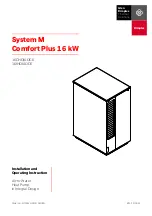
Applications Manual Bosch Geothermal Heat Pumps
| 85
Bosch Thermotechnology Corp.
Data subject to change
11.6 Pond and Lake Geothermal Applications
Pond or lake geothermal applications typically involve
either a coil of piping in the body of water, or the use of a
“lake plate”. Pond and lake heat exchangers, either pond/
lake loop, or lake plates, are two of the most cost effective
applications of all residential geothermal heat pump
systems.
These heat exchangers are utilized when the residential
structure is close to a body of surface water (pond or
lake). The system functions similarly to a closed-loop
ground heat exchanger.
This type of loop system typically require less excavation
than vertical or horizontal loops, with the typical piping
connected to the loop or lake plate in the body of water
a short distance from the structure. There is no boring as
with vertical loops, and the only trench excavation (as with
horizontal loops) is from the structure to the pond or lake.
The pond or lake water provides superb heat transfer to or
from the piping, as the thermal conductivity of water (its
ability to exchange heat) is considerably higher that the
conductivity of any other uid.
11.6.1 Pond or Lake Coils
With pond or lake piping coils, the piping is simply placed
at appropriate levels of the pond or lake to reject heat
from the structure to the water during summer months,
and absorb heat from the water that is transferred to the
structure during winter months. The pipe may be coiled in
a “Slinky™” shape to t more of it into a given amount of
space, and are similar to the “Slinky™” design utilized in
many horizontal ground heat exchanger applications (Fig.
93).
Fig. 93
Typically, a half-acre of water is usually adequate to
support an average residential structure, and IGSHPA
recommends a minimum of ½ acre per ton of cooling
capacity requirements. The body of water should be
within 150-300 feet of the structure to eliminate excessive
excavation and reduce installation costs.
HDPE (polyethylene) piping is run to the water
underground and then long sections of piping and/or
coils are submerged. The piping and/or coils are placed
in and anchored at approximately an 8 to 10 foot depth
in the body of water. Water in its “heaviest” state is
approximately 39ºF and tends to rest in its own isolated
temperature layer in the body of water throughout the
year. This is where the coil of pipe is ideally placed. In
winter, as heat is extracted from the 39ºF water around
the loop coils, the water cools and ascends by way of its
own convective current upward toward the surface. This
draws in “fresh” ambient 39ºF water from the “thermo
cline” (thin but distinct layer in a body of water in which
temperature changes more rapidly than it does in the
layers above or below) directly around the coils. Similarly
in summer, as heat is rejected, the warmed water also
migrates upward away from the coils as cooler ambient
water is drawn back in around them.
The coils of pipe are typically 300 to 500 feet in length,
but could be different depending on the load. Typically,
the same type of HDPE pipe materials that are used for
earth loops are used for pond and lake coil systems. Pipe
length requirements per nominal ton of cooling typically
are shorter and the piping coils can usually be arranged in
a more compact arrangement, as compared to ground heat
exchangers.
In some cases, spools of HDPE pipe are tted with
intermittent spacers between the pipe layers to allow
convective water ow between them. Often coils are
simply spread out at in a consolidated “Slinky™” array. In
each case, the piping coil is usually constructed on shore,
somehow lightly weighted (air inside the pipe coils should
still keep them moderately buoyant), oated into the pond,
and sunk during system lling.
In most applications, ice can form on the surface of the
pond or lake during the winter, but the temperature at
the bottom of the pond or lake typically remains relatively
constant and unfrozen providing an abundant supply of
geothermal heat.
In warmer southern U.S. applications the “Slinky™” style
is recommended (Fig. 94). Due to pipe and antifreeze
buoyancy, pond heat exchangers will need weight added
to the piping to prevent oating. Typically fencing or blocks
are used.
In colder northern U.S. applications the “Slinky™”/“matt
style” is recommended due to its superior performance
in heating (Fig. 94). Due to pipe and antifreeze buoyancy,
pond heat exchangers will need weight added to the
piping to prevent oating. 300 foot coils typically require
two 4” x 8” x 16” blocks or 8-10 bricks, and every 20 Ft.
of 1-1/4” supply/return piping requires 1 three-hole block.
Pond coils should be supported off of the bottom by the
concrete blocks. Typical southern and northern versions
are shown (Fig. 95).
















































